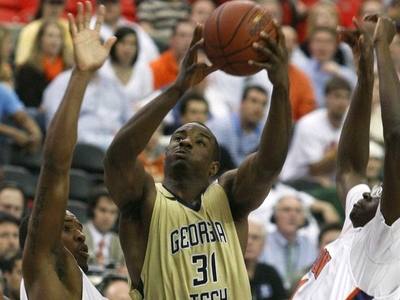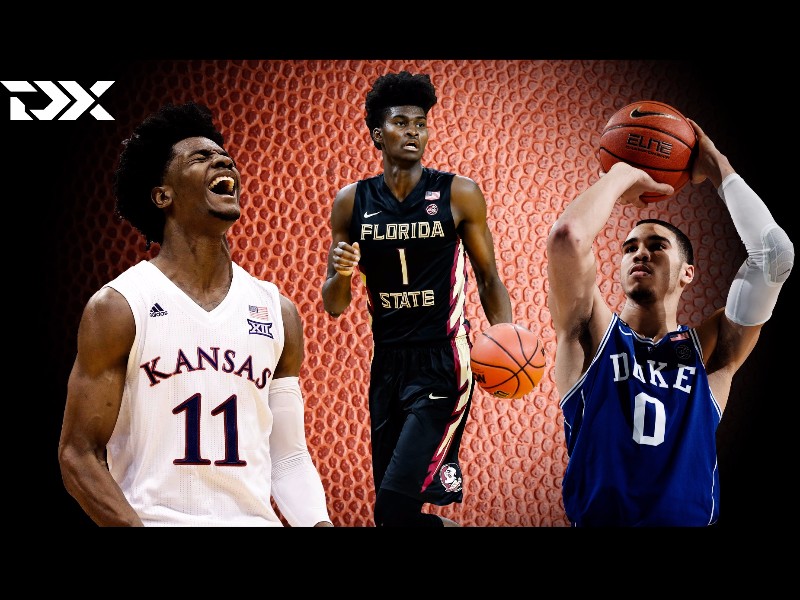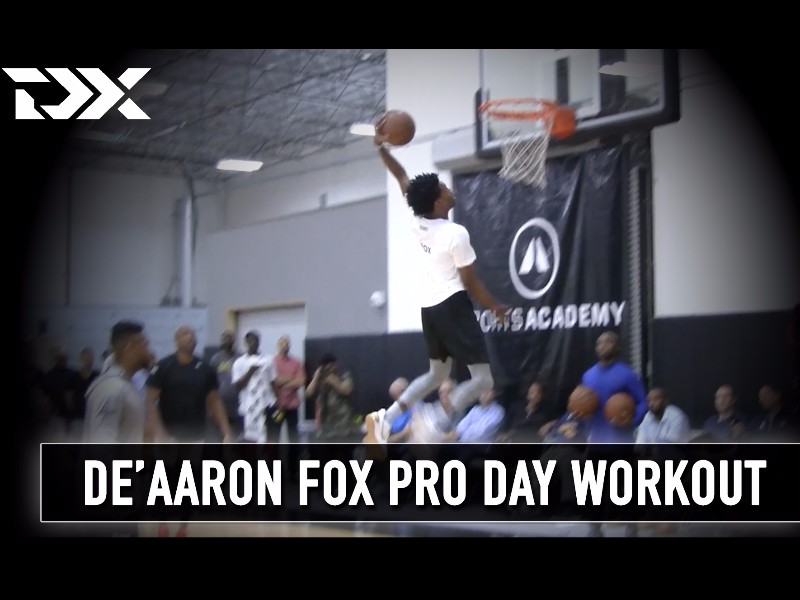As a reminder, incoming freshmen have been excluded from this series.
-Top NBA Draft Prospects in the Big Ten Part One (#1-5), Part Two (#6-10), Part Three (#11-15)
-Top NBA Draft Prospects in the Big 12 Part One (#1-5), Part Two (#6-10), Part Three (#11-15)
-Top NBA Draft Prospects in the Pac-10 Part One (#1-5), Part Two (#5-10)
-Top NBA Draft Prospects in the SEC Part One (#1-5), Part Two (#5-10), Part Three (#11-15),
Part Four
-Top NBA Draft Prospects in the Big East Part One (#1-5), Part Two (#6-10), http://www.draftexpress.com/article/Top-NBA-Draft-Prospects-in-the-Big-East-Part-Three-11-153327
-Top NBA Draft Prospects in the ACC Part One (#1-5)
#6 Trevor Booker, 68, Senior, Power Forward, Clemson
Having profiled Booker briefly this summer, well wait until the season kicks off to revisit his scouting report.
#7 Gani Lawal, 68, Junior, Power Forward, Georgia Tech
Having profiled Lawal late last season, well wait until the season is underway to revisit his scouting report.
#8 Sylven Landesberg, 66, Sophomore, Shooting Guard, Virginia
Joseph Treutlein
One of the most productive freshmen in the country last season, Sylven Landesberg had a good freshman season on an individual level, even though his team struggled to a disappointing 10-17 record. While most of their core players return this year, Virginia doesnt have a noteworthy recruiting class, so Landesberg should have a tough time once again this season.
Offensively, there is a lot to like about Landesberg, starting with his relentless, attacking style of play, which has him constantly trying to take his man off the dribble and get to the basket. Combining a pretty quick first step with long strides, excellent body control, and a good handle with either hand, Landesberg is a tough cover in isolation. Things arent all great in this area of his game, however, as when he gets to the basket, his finishing ability varies depending on the situation, and certainly isnt helped by the very high degree of attention defenses pay him. While Landesberg is great at drawing contact and getting to the line, and even has shown the ability to finish through it, he doesnt have the greatest vertical explosiveness around the rim, leading to some troubles when matched with multiple defenders. In addition, while he has a floater that looks very nice at times, hes awfully inconsistent with it.
Another reason Landesbergs dribble-drive game isnt near its peak is because smart defensive teams will frequently sag off him, forcing him to beat them with his jumpshot, which is still a work in progress. As a jump shooter, Landesberg is actually quite good when unguarded, averaging 1.3 points per possession in these instances according to Synergy Sports Technology, but he drops to a truly awful 0.18 points per possession on guarded jump shots, illustrating a major problem area with his game. Looking at his jumper, its easy to see why he struggles with a hand in his face, as his shot could use a few mechanical fixes. He tends to push the ball a bit on his shot while having a slight hitch in his motion, and he often doesnt get his legs underneath him, something that becomes more likely when hes rushed. Landesberg clearly has a lot of natural shooting ability, and his efficiency on open looks and from the free-throw line is encouraging, but cleaning up his mechanics so he can become a more dynamic shooter should definitely be among his priorities and could vastly improve his game.
As for the rest of his offense, Landesberg demonstrates good court vision and passing ability on occasion, and dishes out a respectable 2.8 assists per game for a wing, but he definitely struggles to find a balance between passing and scoring, which will remain a difficult task on a very unbalanced Virginia offense, where a huge burden of shot creation falls on his shoulders. Landesbergs awareness is also a cause for concern, as he often will force dribble-drives into double teams and display tunnel vision looking for his own shot in the lane, though some of that can be credited to youth and being on an offense that asks so much of him. Itll be interesting to see how this develops in the coming years.
Defensively, Landesberg shows high effort and awareness levels, always keeping his head up and frequently flying across the court to contest jump shots in Virginias zone. Fundamentally, he is also strong, making good use of his physical tools, namely his length, by pressuring the opposition and contesting shots. He has just average speed laterally, but he does a good job keeping his man in front of him with his constant focus and good fundamentals.
Looking forward, Landesberg projects as a likely first round pick when he comes out due to his solid size along with excellent ability in the dribble-drive game, but scouts may have a tough time getting an accurate read on him in the situation hes a part of. There are definitely questions about how he will adjust to playing a more complementary role in the pros, though improving his jump shot would definitely alleviate some of the concerns about how his game will translate.
One of the most productive freshmen in the country last season, Sylven Landesberg had a good freshman season on an individual level, even though his team struggled to a disappointing 10-17 record. While most of their core players return this year, Virginia doesnt have a noteworthy recruiting class, so Landesberg should have a tough time once again this season.
Offensively, there is a lot to like about Landesberg, starting with his relentless, attacking style of play, which has him constantly trying to take his man off the dribble and get to the basket. Combining a pretty quick first step with long strides, excellent body control, and a good handle with either hand, Landesberg is a tough cover in isolation. Things arent all great in this area of his game, however, as when he gets to the basket, his finishing ability varies depending on the situation, and certainly isnt helped by the very high degree of attention defenses pay him. While Landesberg is great at drawing contact and getting to the line, and even has shown the ability to finish through it, he doesnt have the greatest vertical explosiveness around the rim, leading to some troubles when matched with multiple defenders. In addition, while he has a floater that looks very nice at times, hes awfully inconsistent with it.
Another reason Landesbergs dribble-drive game isnt near its peak is because smart defensive teams will frequently sag off him, forcing him to beat them with his jumpshot, which is still a work in progress. As a jump shooter, Landesberg is actually quite good when unguarded, averaging 1.3 points per possession in these instances according to Synergy Sports Technology, but he drops to a truly awful 0.18 points per possession on guarded jump shots, illustrating a major problem area with his game. Looking at his jumper, its easy to see why he struggles with a hand in his face, as his shot could use a few mechanical fixes. He tends to push the ball a bit on his shot while having a slight hitch in his motion, and he often doesnt get his legs underneath him, something that becomes more likely when hes rushed. Landesberg clearly has a lot of natural shooting ability, and his efficiency on open looks and from the free-throw line is encouraging, but cleaning up his mechanics so he can become a more dynamic shooter should definitely be among his priorities and could vastly improve his game.
As for the rest of his offense, Landesberg demonstrates good court vision and passing ability on occasion, and dishes out a respectable 2.8 assists per game for a wing, but he definitely struggles to find a balance between passing and scoring, which will remain a difficult task on a very unbalanced Virginia offense, where a huge burden of shot creation falls on his shoulders. Landesbergs awareness is also a cause for concern, as he often will force dribble-drives into double teams and display tunnel vision looking for his own shot in the lane, though some of that can be credited to youth and being on an offense that asks so much of him. Itll be interesting to see how this develops in the coming years.
Defensively, Landesberg shows high effort and awareness levels, always keeping his head up and frequently flying across the court to contest jump shots in Virginias zone. Fundamentally, he is also strong, making good use of his physical tools, namely his length, by pressuring the opposition and contesting shots. He has just average speed laterally, but he does a good job keeping his man in front of him with his constant focus and good fundamentals.
Looking forward, Landesberg projects as a likely first round pick when he comes out due to his solid size along with excellent ability in the dribble-drive game, but scouts may have a tough time getting an accurate read on him in the situation hes a part of. There are definitely questions about how he will adjust to playing a more complementary role in the pros, though improving his jump shot would definitely alleviate some of the concerns about how his game will translate.
#9 Iman Shumpert, 6'4, Sophomore, Guard, Georgia Tech
Scott Nadler
Georgia Techs sophomore guard Iman Shumpert was thrown into the fire last season and called upon to shoulder much of the responsibility in the backcourt an arduous task to say the least for a freshman on a young team. On the surface, Shumpert did a solid job and earned himself all freshman team honors in the ACC, despite the Yellow Jackets going 2-14 in the ACC and 11-18 overall. Further analyzing his production however, shows that Shumpert has good potential, but did struggle mightily and must make great improvements to solidify himself as a legitimate NBA prospect.
Even though Shumpert played the point for the majority of last season, hes naturally more of a modern day combo guard. At 64 and 200 pounds, Shumpert has good size and strength and has the ability to play on and off the basketball. He does have a tendency however to be a bit ball dominant often over-dribbling the ball causing stagnant possessions. He can create his own shot in one on one situations and is also comfortable making plays for others, which shows his wide skill set. Athletically, he doesnt possess great blow by speed lacking explosion on his drives to the basket, although he does get off the ground well once hes there and gets to the free throw line as well, shooting 4.2 free throws a game (65.6%).
To make up for his lack of speed, Shumpert has developed a nice midrange game, often getting off a decent shot in the half court by creating enough space with his dribble. He has great mechanics on his shot, but only shot 32% on his jump shots inside 17 feet, and a measly 16% on jump shots from 17 feet to inside the 3 point line according to Synergy Sports Technology. Overall, Shumpert was 19th worst amongst all players last season in field goal percentage , shooting just 39.1%. This low percentage is due in large part to his poor shot selection and lack of help on the perimeter.
His poor decision making skills as a whole, made Shumpert one of the most inefficient players in the country last season. Even with his double digit scoring average of 10.6 points a game, Shumpert scored only 0.85 points/possession which was 6th worst in our entire database . Furthermore, his ability to take care of the basketball was nothing to write home about either, as he coughed the ball up 3.7 times a game last year which accounted for 30% of his possessions, 3rd highest percentage in the nation .
On a positive note, Shumperts high assist numbers brought his assist to turnover ratio to a very respectful 1.33. He averaged 5.7 assists per 40 pace adjusted which accounted for 40% of his possessions impressive numbers for a freshman guard. He has very good vision and his size certainly contributes to that. In pick and roll situations, he showed the ability to make difficult passes to the roll man with either looks off the dribble or by seeing over the defense to find his target. He did force it from time to time, but its encouraging to see his above average ability to see the floor.
On the defensive end, Shumperts numbers dont reflect his true impact, or lack thereof, on this end of the floor. He averaged 2.1 steals a game which was good for 14th in the country , but his lack of discipline and gambling nature are the reasons for those high numbers. Hes rarely in a stance and does a mediocre job at fighting through screens which could be a result of effort or conditioning. In addition, he fails to close out and contest open shots on many opportunities due to his roaming style which leaves him out of position. He does possess a long wingspan and thus should improve on this end of the court. As of now however, he has a long way to go.
Life will be a little bit easier this season for Shumpert with the addition of highly touted freshman big man Derrick Favors. Nonetheless, Shumpert will need to show that he can play under control and improve his overall efficiency. If he can do that, Paul Hewitts squad will surely improve and have a chance to get back into the NCAA tournament.
Georgia Techs sophomore guard Iman Shumpert was thrown into the fire last season and called upon to shoulder much of the responsibility in the backcourt an arduous task to say the least for a freshman on a young team. On the surface, Shumpert did a solid job and earned himself all freshman team honors in the ACC, despite the Yellow Jackets going 2-14 in the ACC and 11-18 overall. Further analyzing his production however, shows that Shumpert has good potential, but did struggle mightily and must make great improvements to solidify himself as a legitimate NBA prospect.
Even though Shumpert played the point for the majority of last season, hes naturally more of a modern day combo guard. At 64 and 200 pounds, Shumpert has good size and strength and has the ability to play on and off the basketball. He does have a tendency however to be a bit ball dominant often over-dribbling the ball causing stagnant possessions. He can create his own shot in one on one situations and is also comfortable making plays for others, which shows his wide skill set. Athletically, he doesnt possess great blow by speed lacking explosion on his drives to the basket, although he does get off the ground well once hes there and gets to the free throw line as well, shooting 4.2 free throws a game (65.6%).
To make up for his lack of speed, Shumpert has developed a nice midrange game, often getting off a decent shot in the half court by creating enough space with his dribble. He has great mechanics on his shot, but only shot 32% on his jump shots inside 17 feet, and a measly 16% on jump shots from 17 feet to inside the 3 point line according to Synergy Sports Technology. Overall, Shumpert was 19th worst amongst all players last season in field goal percentage , shooting just 39.1%. This low percentage is due in large part to his poor shot selection and lack of help on the perimeter.
His poor decision making skills as a whole, made Shumpert one of the most inefficient players in the country last season. Even with his double digit scoring average of 10.6 points a game, Shumpert scored only 0.85 points/possession which was 6th worst in our entire database . Furthermore, his ability to take care of the basketball was nothing to write home about either, as he coughed the ball up 3.7 times a game last year which accounted for 30% of his possessions, 3rd highest percentage in the nation .
On a positive note, Shumperts high assist numbers brought his assist to turnover ratio to a very respectful 1.33. He averaged 5.7 assists per 40 pace adjusted which accounted for 40% of his possessions impressive numbers for a freshman guard. He has very good vision and his size certainly contributes to that. In pick and roll situations, he showed the ability to make difficult passes to the roll man with either looks off the dribble or by seeing over the defense to find his target. He did force it from time to time, but its encouraging to see his above average ability to see the floor.
On the defensive end, Shumperts numbers dont reflect his true impact, or lack thereof, on this end of the floor. He averaged 2.1 steals a game which was good for 14th in the country , but his lack of discipline and gambling nature are the reasons for those high numbers. Hes rarely in a stance and does a mediocre job at fighting through screens which could be a result of effort or conditioning. In addition, he fails to close out and contest open shots on many opportunities due to his roaming style which leaves him out of position. He does possess a long wingspan and thus should improve on this end of the court. As of now however, he has a long way to go.
Life will be a little bit easier this season for Shumpert with the addition of highly touted freshman big man Derrick Favors. Nonetheless, Shumpert will need to show that he can play under control and improve his overall efficiency. If he can do that, Paul Hewitts squad will surely improve and have a chance to get back into the NCAA tournament.
#10 Tony Woods, 611, Sophomore, Center, Wake Forest
Joey Whelan
The Demon Deacons will have no shortage of size next season with a trio of near 7-footers and standout sophomore Al-Farouq Aminu all returning to Winston Salem. While it was Aminu and the now departed Jeff Teague who introduced themselves to the national scene last year, this may be the season that sophomore Tony Woods starts to realize some of the potential that made him an elite recruit coming out of Rome High School in Georgia. Though he barely made a dent statistically with his 3.2 points and 2.6 rebounds in less than 11 minutes per-game last season, he showed loads of upside in brief flashes.
The first thing that stands out about Woods is his NBA-ready body. At nearly 6-11 with a massive wingspan and weighing in at nearly 250-pounds, the youngster has more than enough girth to handle playing in the post at the next level. He is an explosive leaper and finisher for a big man and has surprising agility as well, showing the potential to take defenders off the dribble in the future as his handle improves. While he doesnt always push himself, Woods certainly is a good open floor runner and could be a dynamic finisher in transition once he gets more comfortable in his body.
Its no surprise that the sophomore attempted nearly two-thirds of his shots on touches in the immediate vicinity of the basket (according to Synergy Sports). Woods has the type of size and strength that when he begins to polish his post game he will be very difficult to stop in one-on-one situations on the block. He does an excellent job of establishing position, but once he receives the ball his lack of skill development quickly becomes evident. Woods looks very uncomfortable handling the ball in really any situation, not just the post, but he often turns the ball over in an attempt to get to the basket while operating on the block. His back to the basket game seems extremely basic at this point, relying mainly on strength to push defenders around, but on occasion he has shown the ability to seal on a nice drop step and finish. His ability to develop his offensive repertoire will be a major part of how he's percieved down the road.
When Woods gets the basketball around the rim either on dump offs from teammates or offensive rebounds, he looks to dunk everything. There is no question he is a powerful finisher, who with time could become a solid scoring option at the college level. However, to improve his NBA prospects, he needs to begin working on finishing in ways other than trying to power everything home. On the few occasions last season where Woods attempted short turnaround jumpers, he missed badly, often overshooting the basket completely. He hasnt shown much touch to begin with and his 45.5 percent free throw shooting numbers are certainly a good indication of where he stands in regards to his mid-range game.
Where there seems to be a great deal of potential for Woods is in his ability to attack the basket when stepping away from the post. He has shown the quickness to beat slower defenders off the dribble, but his terrible handles prevent him from being much of a threat right now. He is exclusively a straight line driver on the rare occasion when he does put the ball on the floor and it even appears as though he isnt entirely comfortable dribbling with his head up yet. Still, a player who is nearly 7-feet tall and displays his kind of quickness could become a weapon with additional polish.
Defense is where Woods has shown the most promise thus far, as is often the case with players his size at an early age. He is very tough to back down in the post and his length and leaping ability allow him to alter a tremendous number of shots in his area. He hasnt been challenged much yet away from the basket, but it will certainly be paramount for him to be able to guard somewhat quicker players away from the paint on occasion, as well as defend the pick and roll.
Woods is a very long way off from being NBA-ready as far as his game is concerned, but its hard to not look at him and see a bright future if he puts in the work developing his skills. Physically the sophomore has the size and athleticism to play at the next level; he just needs to get comfortable in his own skin. Many times last year he looked awkward when operating on the offensive end of the floor, but every so often, he would be able to put it all together just long enough to make the kind of play that will catch the attention of more than a few scouts. With the great likelihood that he will receive significantly more playing time this year, it will be interesting to see how Woods has developed during the off-season.
The Demon Deacons will have no shortage of size next season with a trio of near 7-footers and standout sophomore Al-Farouq Aminu all returning to Winston Salem. While it was Aminu and the now departed Jeff Teague who introduced themselves to the national scene last year, this may be the season that sophomore Tony Woods starts to realize some of the potential that made him an elite recruit coming out of Rome High School in Georgia. Though he barely made a dent statistically with his 3.2 points and 2.6 rebounds in less than 11 minutes per-game last season, he showed loads of upside in brief flashes.
The first thing that stands out about Woods is his NBA-ready body. At nearly 6-11 with a massive wingspan and weighing in at nearly 250-pounds, the youngster has more than enough girth to handle playing in the post at the next level. He is an explosive leaper and finisher for a big man and has surprising agility as well, showing the potential to take defenders off the dribble in the future as his handle improves. While he doesnt always push himself, Woods certainly is a good open floor runner and could be a dynamic finisher in transition once he gets more comfortable in his body.
Its no surprise that the sophomore attempted nearly two-thirds of his shots on touches in the immediate vicinity of the basket (according to Synergy Sports). Woods has the type of size and strength that when he begins to polish his post game he will be very difficult to stop in one-on-one situations on the block. He does an excellent job of establishing position, but once he receives the ball his lack of skill development quickly becomes evident. Woods looks very uncomfortable handling the ball in really any situation, not just the post, but he often turns the ball over in an attempt to get to the basket while operating on the block. His back to the basket game seems extremely basic at this point, relying mainly on strength to push defenders around, but on occasion he has shown the ability to seal on a nice drop step and finish. His ability to develop his offensive repertoire will be a major part of how he's percieved down the road.
When Woods gets the basketball around the rim either on dump offs from teammates or offensive rebounds, he looks to dunk everything. There is no question he is a powerful finisher, who with time could become a solid scoring option at the college level. However, to improve his NBA prospects, he needs to begin working on finishing in ways other than trying to power everything home. On the few occasions last season where Woods attempted short turnaround jumpers, he missed badly, often overshooting the basket completely. He hasnt shown much touch to begin with and his 45.5 percent free throw shooting numbers are certainly a good indication of where he stands in regards to his mid-range game.
Where there seems to be a great deal of potential for Woods is in his ability to attack the basket when stepping away from the post. He has shown the quickness to beat slower defenders off the dribble, but his terrible handles prevent him from being much of a threat right now. He is exclusively a straight line driver on the rare occasion when he does put the ball on the floor and it even appears as though he isnt entirely comfortable dribbling with his head up yet. Still, a player who is nearly 7-feet tall and displays his kind of quickness could become a weapon with additional polish.
Defense is where Woods has shown the most promise thus far, as is often the case with players his size at an early age. He is very tough to back down in the post and his length and leaping ability allow him to alter a tremendous number of shots in his area. He hasnt been challenged much yet away from the basket, but it will certainly be paramount for him to be able to guard somewhat quicker players away from the paint on occasion, as well as defend the pick and roll.
Woods is a very long way off from being NBA-ready as far as his game is concerned, but its hard to not look at him and see a bright future if he puts in the work developing his skills. Physically the sophomore has the size and athleticism to play at the next level; he just needs to get comfortable in his own skin. Many times last year he looked awkward when operating on the offensive end of the floor, but every so often, he would be able to put it all together just long enough to make the kind of play that will catch the attention of more than a few scouts. With the great likelihood that he will receive significantly more playing time this year, it will be interesting to see how Woods has developed during the off-season.


































Comments